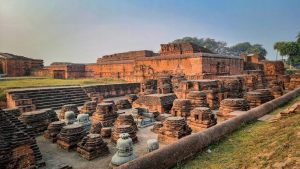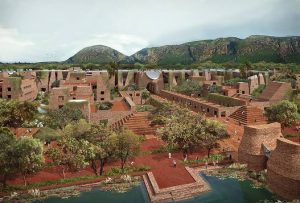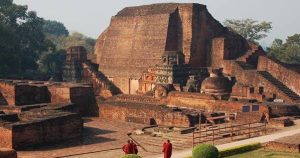Digital News Guru Bihar Desk:
Nalanda University: The Ancient Seat of Learning
Nalanda University, located in modern-day Bihar, India, was one of the world’s first and most renowned centers of higher learning. Flourishing between the 5th and 12th centuries CE, it served as a hub of knowledge and intellectual exchange, attracting scholars from across the globe. Its sprawling campus and advanced educational methods earned it a legendary status, and its influence continues to inspire modern institutions.
This article explores the history, significance, architecture, and eventual decline of Nalanda University while reflecting on its enduring legacy in the modern era.
Historical Background
Nalanda University was established during the Gupta Empire, under the patronage of Emperor Kumaragupta I (circa 5th century CE). The university’s name is derived from “Na-Alam-Da,” meaning “insatiable in giving,” symbolizing its commitment to imparting limitless knowledge.

Nalanda gained prominence under successive rulers, especially the Guptas and later the Pala dynasty, who were ardent supporters of Buddhism. The institution became an unparalleled center for Buddhist studies, although it also offered teachings in Hinduism, Jainism, mathematics, astronomy, medicine, logic, and philosophy.
The university became a global beacon for scholars, drawing students and teachers from as far as China, Tibet, Korea, Central Asia, and Southeast Asia. Renowned figures such as the Chinese traveler Xuanzang and the Tibetan scholar Atisha are closely associated with Nalanda, documenting its glory and intellectual vibrancy.
Academic Excellence and Teaching Methods
Nalanda University was not just a collection of classrooms but an organized and thriving academic community. At its peak, the university housed over 10,000 students and 2,000 teachers. Admission was highly selective, with rigorous oral examinations conducted by the gatekeepers.
Curriculum
The curriculum at Nalanda was diverse and holistic, covering:
- Buddhist Scriptures: Primarily Mahayana Buddhism but also Hinayana texts.
- Philosophy and Logic: Emphasizing critical thinking and debate.
- Sciences: Astronomy, medicine, and mathematics were prominent.
- Languages and Literature: Sanskrit, Pali, and various regional languages.
Nalanda’s teaching methods were ahead of their time. The university emphasized critical inquiry, interactive discussions, and interdisciplinary learning, which remain hallmarks of modern education systems.
International Collaboration
Nalanda’s global reputation was further strengthened by scholars such as Xuanzang (Hsuan Tsang) and Yijing, who visited the university during their travels. Their writings provide detailed accounts of the university’s academic rigor, daily life, and architectural magnificence.
Architectural Grandeur
Nalanda’s sprawling campus, spread across 12 million square feet, was a marvel of ancient Indian architecture. Archaeological excavations reveal a meticulously planned layout with nine-story libraries, lecture halls, monasteries (viharas), and temples (chaityas).
Key Architectural Features
- Library (Dharmaganja):
The library complex was one of Nalanda’s most remarkable features. It consisted of three main buildings: Ratnasagara (Ocean of Jewels), Ratnadadhi (Sea of Jewels), and Ratnaranjaka (Delighter of Jewels). These housed a vast collection of manuscripts, scrolls, and texts, preserved meticulously for centuries. - Monasteries and Stupas:
The campus included numerous viharas for residential and academic purposes, along with stupas and shrines dedicated to the Buddha. The Sculptural reliefs and inscriptions on the structures are notable for their artistic brilliance. - Water Reservoirs and Gardens:
The university also boasted advanced water management systems and landscaped gardens, underscoring the emphasis on creating a conducive learning environment.
Decline and Destruction
Nalanda University’s decline began in the late 12th century, coinciding with the fall of the Pala dynasty. The final blow came in 1193 CE when the university was attacked by Bakhtiyar Khilji, a general of the Turkic Muslim ruler Qutb-ud-din Aibak. The invaders destroyed the buildings and set fire to the vast libraries. Historical accounts suggest that the libraries burned for months, signaling the tragic loss of centuries of knowledge.
The university was abandoned and fell into obscurity, with its ruins left to be consumed by time. However, its legacy endured through the accounts of travelers and scholars who preserved its memory.
Rediscovery and Legacy
The ruins of Nalanda were rediscovered in the 19th century during British rule in India. Systematic archaeological excavations began in the early 20th century, revealing the scale and significance of the ancient university.
Cultural and Global Impact
Nalanda’s influence transcended geographical boundaries, inspiring the establishment of other ancient universities such as Taxila, Vikramashila, and Somapura. Its emphasis on interdisciplinary learning, critical inquiry, and global collaboration resonates with modern educational ideals.
UNESCO World Heritage Status
In 2016, the ancient ruins of Nalanda were recognized as a UNESCO World Heritage Site, reaffirming its place in global history as a center of learning and cultural exchange.

Tourist and Scholarly Appeal
Today, Nalanda is a major tourist attraction, drawing history enthusiasts, scholars, and spiritual seekers. Key attractions include:
- Nalanda Archaeological Museum: Housing artifacts, sculptures, and inscriptions from the site.
- Xuanzang Memorial Hall: Dedicated to the Chinese scholar who documented Nalanda’s glory.
- Rajgir and Bodh Gaya: Nearby spiritual destinations linked to Buddhism.
Conclusion
Nalanda University remains a shining example of India’s intellectual and cultural heritage. Its legacy as an ancient seat of learning continues to inspire educational and philosophical endeavors worldwide. Whether as a historical marvel or a symbol of academic excellence, Nalanda’s story is a timeless testament to humanity’s quest for knowledge, wisdom, and understanding.
Through its modern revival, Nalanda offers a bridge between the past and the future, embodying the enduring values of learning and enlightenment.
You May Also Read: Vivekananda Rock Memorial, Kanyakumari: A Monument of Spirituality and Inspiration









